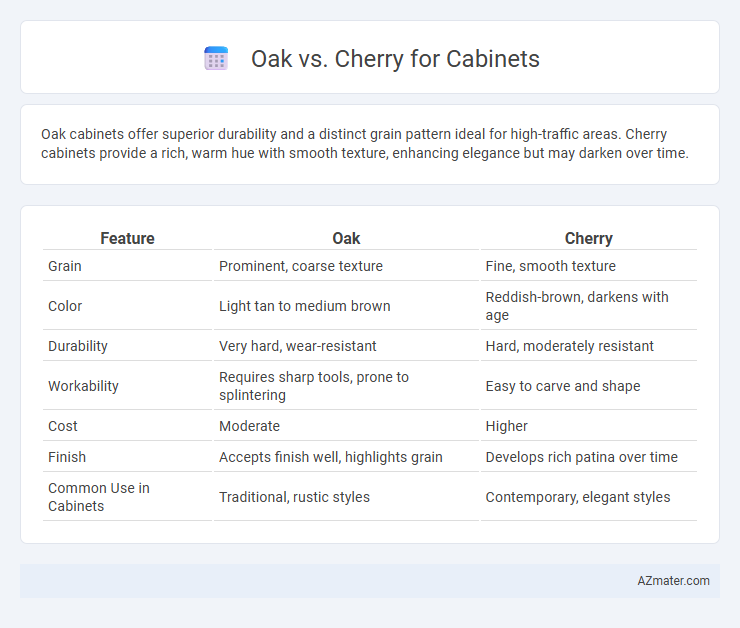Oak cabinets offer superior durability and a distinct grain pattern ideal for high-traffic areas. Cherry cabinets provide a rich, warm hue with smooth texture, enhancing elegance but may darken over time.
Table of Comparison
| Feature | Oak | Cherry |
|---|---|---|
| Grain | Prominent, coarse texture | Fine, smooth texture |
| Color | Light tan to medium brown | Reddish-brown, darkens with age |
| Durability | Very hard, wear-resistant | Hard, moderately resistant |
| Workability | Requires sharp tools, prone to splintering | Easy to carve and shape |
| Cost | Moderate | Higher |
| Finish | Accepts finish well, highlights grain | Develops rich patina over time |
| Common Use in Cabinets | Traditional, rustic styles | Contemporary, elegant styles |
Introduction: Oak vs Cherry Cabinets
Oak cabinets offer exceptional durability and prominent grain patterns, making them ideal for traditional and rustic kitchen designs. Cherry cabinets provide a smooth texture and rich, warm tones that deepen over time, perfect for elegant and classic interiors. Both woods deliver long-lasting beauty, with oak known for strength and cherry for its luxurious aging process.
Wood Characteristics: Oak and Cherry
Oak wood is highly valued for its strength, coarse texture, and prominent grain patterns that range from straight to wavy, providing a rustic and durable appearance for cabinets. Cherry wood is known for its smooth texture and fine grain with a consistent reddish-brown hue that deepens over time, creating a warm, elegant look. Oak offers superior hardness and resistance to wear, while cherry presents moderate hardness with excellent workability and refined aesthetics.
Appearance and Grain Patterns
Oak cabinets showcase a pronounced grain pattern with prominent rays and flecks, offering a textured, rustic appeal that suits traditional and farmhouse styles. Cherry cabinets feature a smooth, fine grain with subtle, wavy patterns and a warm reddish-brown hue that deepens over time, delivering a rich, elegant appearance ideal for classic and sophisticated interiors. The distinct grain visibility of oak contrasts with the more uniform and refined look of cherry, influencing the cabinet's visual impact and style compatibility.
Color Variations and Aging
Oak cabinets display a wide range of color variations from light tan to deep reddish-brown, often showcasing prominent grain patterns that darken and warm elegantly over time. Cherry wood cabinets typically start with a rich reddish-brown hue that deepens to a luxurious mahogany shade as they age, developing a smooth patina and subtle darkening. Both woods age gracefully, but oak highlights its texture and brightness, while cherry evolves into a richer, more uniform color.
Durability and Hardness Comparison
Oak cabinets offer superior durability and hardness compared to cherry, making them highly resistant to dents, scratches, and daily wear. Oak has a Janka hardness rating of approximately 1,290, significantly higher than cherry's rating of around 950, ensuring better longevity in high-traffic areas. This makes oak an ideal choice for kitchens requiring robust cabinetry that maintains structural integrity over time.
Cost Differences: Oak vs Cherry
Oak cabinets typically cost less than cherry cabinets due to oak's abundance and faster growth rate, making it a more budget-friendly option for homeowners. Cherry wood, prized for its rich color and smooth grain, commands higher prices because of its slower growth and limited supply, increasing material and labor costs. Choosing oak over cherry can result in significant savings without sacrificing durability, as both woods are strong and long-lasting.
Maintenance and Care Requirements
Oak cabinets demand regular sealing or finishing to maintain their durability and resist moisture, making them relatively low-maintenance yet requiring periodic upkeep. Cherry wood cabinets develop a rich patina over time, needing gentle cleaning with non-abrasive products to preserve their smooth texture and warm hue. Both woods benefit from avoiding excessive humidity and direct sunlight to prevent warping and color fading.
Style and Design Compatibility
Oak cabinets offer a classic, rustic appeal with pronounced grain patterns ideal for traditional or farmhouse-style interiors. Cherry wood provides a smooth, uniform texture and rich reddish tones that complement both classic and contemporary designs. Both woods ensure durability, but oak's robust, textured look suits casual or country aesthetics, while cherry's elegant finish enhances formal, upscale spaces.
Environmental and Sustainability Factors
Oak and cherry cabinets differ significantly in environmental impact and sustainability. Oak trees grow faster and are more widely available, making oak a more sustainable choice due to quicker renewal rates and less deforestation pressure. Cherry wood, valued for its rich color and grain, grows slower and often comes from less abundant sources, raising concerns about long-term environmental impact and sustainability.
Which Wood to Choose for Cabinets?
Oak wood offers exceptional durability and a distinct grain pattern, making it ideal for sturdy, long-lasting cabinets in high-traffic areas. Cherry wood provides a smooth, rich reddish-brown finish that deepens over time, perfect for elegant, warm-toned cabinetry. Choosing between oak and cherry depends on whether you prioritize robustness and traditional texture or a refined, luxurious appearance in your cabinets.

Infographic: Oak vs Cherry for Cabinet
 azmater.com
azmater.com